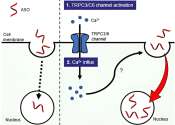Prostate cancer is a form of cancer that develops in the prostate, a gland in the male reproductive system. Most prostate cancers are slow growing; however, there are cases of aggressive prostate cancers. The cancer cells may metastasize (spread) from the prostate to other parts of the body, particularly the bones and lymph nodes. Prostate cancer may cause pain, difficulty in urinating, problems during sexual intercourse, or erectile dysfunction. Other symptoms can potentially develop during later stages of the disease.
Rates of detection of prostate cancers vary widely across the world, with South and East Asia detecting less frequently than in Europe, and especially the United States. Prostate cancer tends to develop in men over the age of fifty and although it is one of the most prevalent types of cancer in men, many never have symptoms, undergo no therapy, and eventually die of other causes. This is because cancer of the prostate is, in most cases, slow-growing, symptom-free, and since men with the condition are older they often die of causes unrelated to the prostate cancer, such as heart/circulatory disease, pneumonia, other unconnected cancers, or old age. On the other hand, the more aggressive prostate cancers account for more cancer-related mortality than any other cancer except lung cancer. About two-thirds of cases are slow growing, the other third more aggressive and fast developing.
Many factors, including genetics and diet, have been implicated in the development of prostate cancer. The presence of prostate cancer may be indicated by symptoms, physical examination, prostate-specific antigen (PSA), or biopsy. The PSA test increases cancer detection but does not decrease mortality. Moreover, prostate test screening is controversial at the moment and may lead to unnecessary, even harmful, consequences in some patients. Nonetheless, suspected prostate cancer is typically confirmed by taking a biopsy of the prostate and examining it under a microscope. Further tests, such as CT scans and bone scans, may be performed to determine whether prostate cancer has spread.
Management strategies for prostate cancer should be guided the severity of the disease. Many low-risk tumors can be safely followed with active surveillance. Curative treatment generally involves surgery, various forms of radiation therapy, or, less commonly, cryosurgery; hormonal therapy and chemotherapy are generally reserved for cases of advanced disease (although hormonal therapy may be given with radiation in some cases).
The age and underlying health of the man, the extent of metastasis, appearance under the microscope and response of the cancer to initial treatment are important in determining the outcome of the disease. The decision whether or not to treat localized prostate cancer (a tumor that is contained within the prostate) with curative intent is a patient trade-off between the expected beneficial and harmful effects in terms of patient survival and quality of life.









